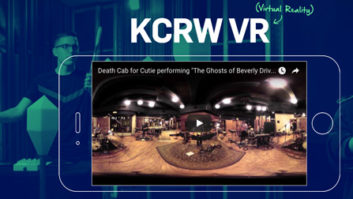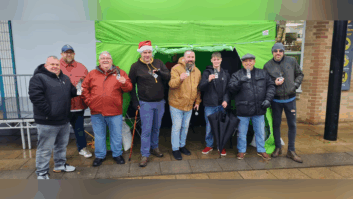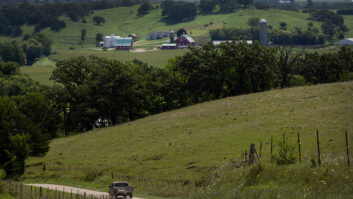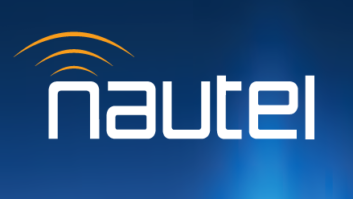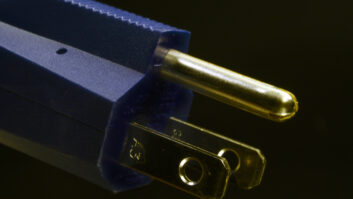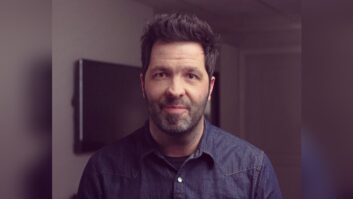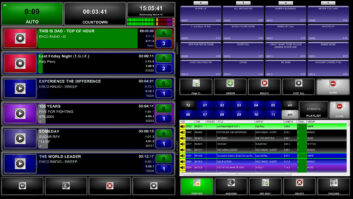FROM THE EDITOR
Virtual reality is firing up a new era of techno-fans; and radio people are finding a way to put the tool to use. Tom Vernon reports for Radio World.
— Paul McLane
Virtual reality got its start in 1965, when computer graphics pioneer Ivan Sutherland wrote about “a room in which the computer can control the existence of matter.” Think the Holodeck on “Star Trek.”
Work began in earnest in the early 1990s, although the results were far removed from the environment that Sutherland envisioned. VR usually involved people wearing hoods with motion sensors along with surround video and sound. Sometimes there were gloves for tactile feedback.
After the novelty wore off, VR just faded from public view. But development didn’t stop, and today VR is making a comeback. Gaming and technology companies such as Sony and HTC are embracing the trend, as is Facebook, which recently purchased VR startup Oculus, in part to build virtual reality versions of its apps.
CES 2016 this winter featured more than 40 exhibitors, expanding VR’s footprint by 77 percent over last year, according to an event press release. Projected sales of virtual reality headsets are expected to increase by 500 percent in 2016, with 1.2 million units sold. Revenue is estimated at $540 million. A VR summit with industry leaders was held at the NAB Show in April.
This may be the year that virtual reality becomes mainstream.

KCRW VR team, from left, Rob LaFond, Alex Pieros, Joey Caroni and Sean Dellorco with the KCRW Cardboard VR viewer

The KCRW VR pageFREE VR APP
There’s nothing like sitting in on a recording session to get an intimate glimpse of musicians at work. They always make it look so easy. But that privilege is usually reserved for a select few.
KCRW, a public broadcaster affiliated with Santa Monica College in California, wants to give this experience to everyone. The station recently released a free virtual reality mobile app that will make performances in its legendary basement studio freely available.
Radio World talked with KCRW President Jennifer Ferro and Director of Digital Media Joey Caroni about what was involved in bringing this technology to the KCRW community, and where it is going in the future.
The VR service makes available select live music performances from “Morning Becomes Eclectic,” a three-hour adult album alternative program that airs weekdays on KCRW. The launch includes VR videos from Death Cab for Cutie, Brandi Carlile, Thundercat and Purity Ring. To experience the VR broadcasts, listeners must download the free app in the iOS and Android stores. For a full stereoscopic 3D experience, users can purchase an optional KCRW Cardboard Viewer that works with their smartphone for a $5 donation to KCRW. The performances are also available as 360-degree videos within the app and on the station’s Facebook and YouTube channels.
While the VR project formally launched in January, it had been on KCRW’s radar and in the planning stages for over a year. Caroni explains that when launching a new venture such as VR, timing is everything.
“We wanted to be an early adopter, but at the same time, didn’t want to launch before we could produce two or three VR recording sessions on a monthly basis. Also, the level of interest needed to be high enough to justify the effort. Now the big players in digital media are on board, and smartphones have the processing capability to display VR properly. We felt that the experience wouldn’t suffer because of the technology.”
Before the launch, KCRW was busy building partnerships with VR players who could help them make a successful debut. GoPro donated the eight HERO4 cameras. Local VR expert Lex Halaby volunteered his time to oversee the fabrication of the mount and modification of the cameras to accommodate wide-angle lenses.

Video Producer Rob LaFond prepares the VR camera for a live session.PUSHING NEW EXPERIENCES
The public media broadcaster was founded in 1945 as a facility to train servicemen about the emerging technology of FM broadcasting. A charter member of NPR in 1970, its programming is a mix of music, news and other spoken-word programming. It airs programs from NPR, Public Radio International, American Public Media and the BBC, along with music programs and live in-studio performances, as well as locally produced news and culture programs. In addition to its network of stations and translators, KCRW has three streams: a rebroadcast of the FM channel, a 24-hour music channel and a 24-hour news service.
KCRW’s VR project is part of a larger movement in public media to give listeners and members new experiences, going far beyond the traditional role of providing jazz or classical music channels.
President Jennifer Ferro elaborated: “We view ourselves as a community of people. Part of our mission is to provide new experiences and open up new avenues to this community. It’s a relationship that we constantly work on, keeping it fresh and a little bit surprising. We’re always on the lookout for the types of experiences that make us a good partner to commit to.”
In addition to the uplifting, spiritual dimension of providing experiences, it has a positive impact on membership and sponsorship. “Providing a good service to our community is part of our ecosystem, so sponsorship seems to follow. Can we see the positive impact? Yes. Can we precisely quantify it? No.”
KCRW’s foray into VR began with live music, but the station is confident that it will find other uses.
“VR is still a technology in search of applications,” said Ferro. “Using it as a medium for storytelling seems to be a natural, and that might be our next step.” Caroni added, “VR can be a vehicle to bring KCRW to entirely different audiences than those who tune in to radio. Possibly a younger audience, a more global audience.”
From a technology perspective, he envisions expanding VR beyond producing videos of recording sessions. “I’d like to see us streaming live VR events. The technology is evolving quickly, but right now it’s very limited as far as who can do it, and who can distribute it.”

A laser-cut custom acrylic rig was fabricated to mount KCRW’s eight GoPro digital cameras. KCRW recently announced plans to capture its first full concert event in VR. “While live VR still isn’t ready for primetime, we are thrilled to announce we will be recording our upcoming concert with Nas for our summer SoundInFocus concert series in full VR and 360 video,”
Caroni said. “This video will be distributed on several different VR platforms reaching all VR headsets and platforms.”
VR can also be used for archiving. As KCRW prepared to leave its old facility and move into a new building, Caroni wanted to save something from the past.
“I’d like to do a 360-degree walkthrough of our basement studios. There’s so much history and so many great performers that passed through that space. A VR guided tour is a way to preserve some of that.”
VR journalism is also in its infancy, but that is an area the station is holding back on for now. “There are some issues with journalistic integrity,” said Caroni. “VR recording on location is a rather elaborate setup, not something you can do on the fly. VR journalism segments can come across as canned or staged. We’re going to wait and see how some of the big players in media handle this.”

KCRW added fisheye lenses to its custom Go-Pros.EDITOR’S TRICKS
Video production and post production of VR material have some unique challenges, Caroni said.
“We need to merge the video feeds from our eight cameras into one seamless 360-degree canvas. But the areas of overlap between cameras — the stitch line — can be iffy. We needed to identify where those stitch lines were in our basement studio, and mark the walls with tape. You don’t want to end up with a performer’s face on a stitch line. We try and have the bands set up in such a way that there’s nothing going on near these zones.”
Most of this work is done with image-stitching software applications. KCRW uses Kolor’s Autopano. This type of software can create panoramas, gigapixel images and 360-degree videos. Caroni adds that the software does some but not all of the work involved in stitching multiple videos together.
The VR project not only gives a new experience to KCRW’s community, it is also an added incentive for bands to perform in the basement studios. “We’ve had estimates of around $65,000 from contractors to produce VR mini concerts. We offer this added value to bands. Perform in our studios, and we’ll shoot a VR video for free, and push it out for you.”
With any new technology venture, there is an education component: explaining to the community what it is, how it works and why it’s exciting. Some of that involves hosts talking it up and explaining it on air, as well as putting information out on social media. The station has also created a VR landing page on its website: kcrw.org/vr. There viewers can watch a VR case study video, sign up for email alerts to upcoming VR concerts and download the app.
Launching a new technology involves teamwork across many areas of the station. Ferro shares some thoughts on best practices. “Start small and experiment. Reach out to people in your community who are the pioneers. These folks usually are anxious to see and be part of a practical application of the technology. It’s also an opportunity for brands and sponsors to learn along with you. Be as public about the process as possible.
“New ventures are inspiring to your staff and are opportunities for them to add new areas of expertise. It’s important to include as many people as possible. The new skills they acquire will enhance their careers and help the station as a whole.”
Tom Vernon is a longtime Radio World contributor.
Tell us how your station is using VR and other new technology tools. Email [email protected].
